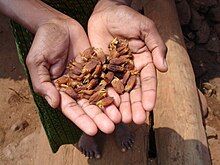This article needs additional citations for verification. (December 2009) |
Forest produce is defined under section 2(4) of the Indian Forest Act, 1927.[1] Its legal definition includes timber, charcoal, caoutchouc, catechu, wood-oil, resin, natural varnish, bark, lac, myrobalans, mahua flowers (whether found inside or brought from a forest or not), trees and leaves, flowers and fruit, plants (including grass, creepers, reeds and moss), wild animals, skins, tusks, horns, bones, cocoons, silk, honey, wax, other parts or produce of animals, and also includes peat, surface soil, rocks and minerals etc. when found inside or brought from a forest, among other things.[1]

Forest produce can be divided into several categories. From the point of view of usage, forest produce can be categorized into three types: Timber, Non Timber and Minor Minerals. Non-timber forest products [NTFPs] are known also as minor forest produce (MFP) or non-wood forest produce (NWFP). The NTFP can be further categorized into medicinal and aromatic plants (MAP), oil seeds, fiber and floss, resins, edible plants, bamboo, reeds and grasses.
- ^ a b "THE INDIAN FOREST ACT, 1927". envfor.nic.in. Retrieved 2017-10-10.